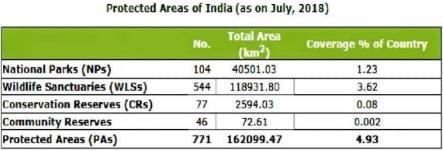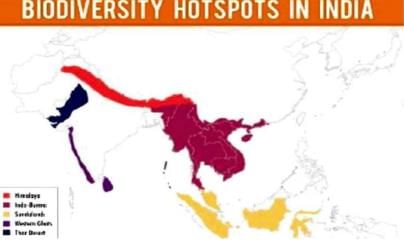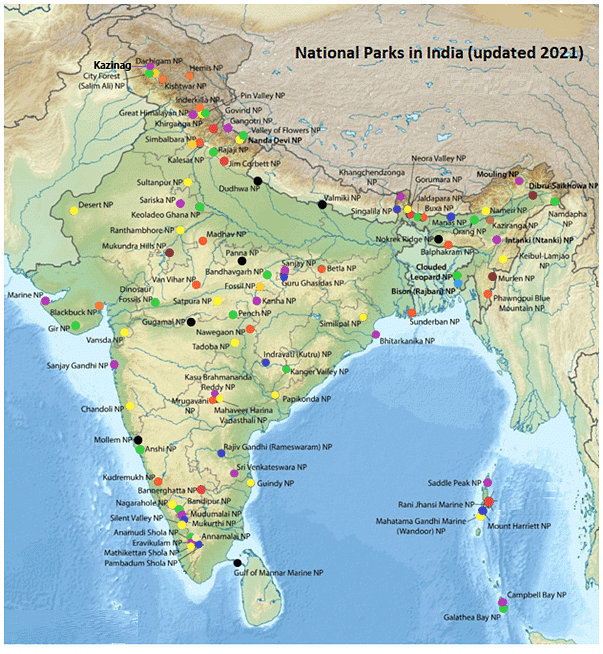Shankar IAS Summary: Protected Area Network | Environment for UPSC CSE PDF Download
Introduction
The Protected Area Network is a crucial topic in environmental conservation and biodiversity management, exploring the establishment and significance of protected areas like national parks, wildlife sanctuaries, and biosphere reserves. This examination delves into their role in preserving ecosystems, safeguarding endangered species, and promoting sustainable development, emphasizing the importance of environmental stewardship.
Wildlife Protection Act 1972
Wildlife Protection in India
In 1972, India pioneered environmental protection in its constitution, following global discussions at the U.N. Conference of Human Environment. World Environment Day is now celebrated worldwide on June 5th.

Constitutional Provisions
- Article-48-A: States must protect the environment and preserve forests and wildlife.
- Article 51-A (g): Every citizen must safeguard the natural environment, including forests, lakes, rivers, and wildlife.
Wildlife (Protection) Act, 1972
- Enacted in 1972, this Act marked a milestone, addressing wildlife protection despite it being a State subject.
- Adopted by all states except Jammu and Kashmir, the Act is mandatory in Union Territories.
- Amended in 1982, 1986, 1991, and 1993, it establishes the framework for wildlife protection and management.
Salient Features
- Originating in 1887, the Act covers protection for wild
Protected Areas (PA)
The adoption of a National Policy for Wildlife Conservation in 1970 and the enactment of the Wildlife (Protection) Act in 1972 lead to a significant growth in the protected areas

Geographical Area of India = 32,87,263 km2
Forest cover of India (FSI, 2015) = 7,01,673 km2
Percentage Area under Forest cover = 21.34 % of Geographical Area of India
Wild Life Sanctuary (WLS)
- The Wild Life (Protection) Act of 1972 provided for the declaration of certain areas by the State Government as wildlife sanctuaries if the area was thought to be of adequate ecological, geo morphological and natural significance.
- There are over 500 wildlife sanctuaries in the country, of Which Tiger Reserves are governed by Project Tiger.
- The Central Government may also declare a sanctuary under certain conditions
National Park (NP)
- The Wild Life (Protection) Act (WPA) of 1972 provided for the declaration of National Parks by the State Government are declared in areas that are considered to be of adequate ecological, geo morphological and natural significance although within the law,
- The difference in conservation value of a National Park from that of a sanctuary is not specified in the WPA 1972
 Difference between the two
Difference between the two
- National Parks enjoy a greater degree of protection than sanctuaries. Certain activities which are regulated in sanctuaries, such as grazing of livestock, are prohibited in National Parks.
- Wildlife sanctuary can be created for a particular species (for e.g. grizzled giant squirrel w.l.s in srivalliputhur) whereas the national park is not primarily focused on a particular species,
Conservation Reserve and Community Reserves
- Outcome of Amendments to the Wild life protection act in 2003 compromising the community needs.
- It provides for a flexible system wherein the wildlife conservation is achieved without

(i) Conservation Reserves
- It is an area owned by the State Government adjacent to National Parks and sanctuaries for protecting the landscape, seascape and habitat of fauna and flora. It is managed through a Conservation Reserve Management Committee
- State Government may, after having consultations with the local communities; declare any area owned by the Government-as conservation reserve.
- Tiruppadaimarathur conservation reserve in Tirunelveli, tamilnadu is the first conservation reserve established in the Country.
(ii) Community Reserve
- State Govt may notify any community land or private land as a Community Reserve, provided that the members of that community or concerned are agreeable to offer such area for protecting the fauna and flora, as well as their traditions, cultures and practices.
- The declaration of such an area is aimed at improving 'the socio-economic conditions of the living in such areas as well as conserving The Reserve is managed through a Reserve Management Committee No change in the land use pattern shall be made within the Community Reserve, except in according with a resolution passed by the management Committee and approval of same by the State Government
Coastal Protected Areas
- It aims to protect and conserve the natural marine ecosystems in their pristine condition
- Marine Protected Area (MPA), as "any area of intertidal or sub tidal terrain, together with its overlaying water and Associated flora, fauna, historical and cultural features, which has been reserved bylaw or other effective means to protect part or all of the enclosed environment"- IUCN.
- The MPAs in marine environment in India, are primarily classified, into following three categories:
- Category-l This covers National Parks and Sanctuaries and having entire areas in intertidal/sub-tidal or mangroves, coral reefs, creeks, seagrass beds, algal beds, estuaries, lagoons.
- Category-ll This includes Islands, which have major parts in marine ecosystem and some part in terrestrial ecosystem.
- Category-lllA This includes sandy beaches beyond intertidal line but occasionally interacting with the seawater.
- Category-lllB This includes ever green or semi ever green forests of Islands

Sacred Groves of India
- Sacred groves comprise of patches of forests or natural vegetation from a few trees to forests of several acres that are usually dedicated to local folk deities.
- In India, sacred groves are found all over the country and abundantly along the western ghats in the states of Kerala and Karnataka
Export - Prohibited Goods
Items listed as prohibited are strictly forbidden for export, and no export licenses will be granted for them. Prohibited items in the flora and fauna category include:
- All wild animals, their articles, and derivatives (except with ownership certificates or for education, research, and management under the Wild Life (Protection) Act, 1972).
- Beef of cows, oxen, and calf, including offal.
- Buffalo meat (both male and female) in fresh, chilled, and frozen forms.
- Peacock Tail Feathers and related handicrafts.
- Shavings and Manufactured Articles of shed antlers.
- Seashells.
- Wood and wood products, including fuel wood and wood charcoal.
- Sandalwood in any form (excluding finished handicrafts, machine-finished products, and sandalwood oil).
- Red Sanders wood and its value-added products.
- Mechanical, chemical, and semi-chemical wood pulp.
The Man and Biosphere
- The Man and the Biosphere (MAB) Programme is an Intergovernmental Scientific Programme aiming to set a scientific basis for the improvement of the relationships between people and their environment globally.
- Launched in the early 1970s, it proposes an interdisciplinary research agenda and capacity building that target the ecological, social and economic dimensions of biodiversity loss and the reduction of this loss.
- Identify and assess the changes in the biosphere resulting from human and natural activities and the effects of these changes on humans and the environment, in particular in the context of climate change; study and compare the dynamic interrelationships between natural/near-natural ecosystems and socio-economic processes
- promote the exchange and transfer of knowledge on environmental problems and solutions, and to foster environmental education for sustainable development ensure basic human welfare and a liveable environment in the context of rapid urbanization and energy consumption as drivers of environmental change
Biosphere Reserve (BR)
- The International coordinating council (ICC) of UNESCO, November, 1971, introduced the designation Biosphere Reserve' for natural areas.
- Biosphere Reserve (BR) is an international designation by UNESCO for representative parts of natural and cultural landscape's extending over large area of terrestrial or coastal/marine ecosystems or a combination thereof.

(ii) Biosphere Reserves: an Indian approach
National Biosphere Reserve Programme. Initiated in 1986.
(iii) Objectives
- To conserve the diversity integrity of plants and animals within natural ecosystems;
- To safeguard genetic diversity of species on which their continuing evolution depend
- To provide areas for multi-faceted research and monitoring;
- To provide facilities for education and training; To ensure sustainable use of natural resources through most appropriate technology for improvement of economic well-being of the local people.
World Network of Biosphe Rereserves
(WNBR)
- Biosphere Reserves (BRs) join the International Network through UNESCO's MAB Programme upon meeting criteria.
- Participation is voluntary, and BRs remain under the sovereignty of the host country/state.
- Delisting is rare, occurring only in cases of violation of conservation obligations after consulting the concerned government.
- Established in 1977, the World Network comprises 610 biosphere reserves in 117 countries, fostering international collaboration, knowledge sharing, and best practices.
Biodiversity Hot Spots
- Biodiversity hot spot concept was put forth by Norman Myers in 1988 To qualify as a hot spot, a region must meet two strict criteria:
- Species endemism - it must contain at least 1,500 species of vascular plants (>0.5% of the world's total) as endemics, and
- Degree of threat-it has to have lost at least 70% of its original habitat.
(i) Indian Biodiversity Hot Spots
- The Eastern Himalayas
- Indo-Burma and
- The western Ghats & Sri Lanka

(ii) Eastern Himalayas Hot Spot:
- The region encompassing Bhutan, north-eastern India, and southern, central, and eastern Nepal. The region is geologically young and shows high altitudinal variation, has nearly 163 globally threatened species (both flora and fauna) including the One horned- Rhinoceros, the Wild Asian Water buffalo.
- A plant species Ermania Himalayans was found at an altitude of 6300 meters in north-western Himalayas.
- A few threatened endemic bird species such as the Himalaya Quail, Cheer pheasant, Western tragopan are found here, along with some of Asia's largest and most endangered birds such as the Himalayan vulture and White-bellied heron.
- Endemic Mammals like the Golden langur, The Himalayan tahr, the pygmy hog, Langurs, Asiatic wild dogs, sloth bears, Gaurs, Muntjac, Sambar, Snow leopard, Mack bear, Blue sheep, Takin, the gangetic dolphin, wild water buffalo, swamp deer call the Himalayan ranged their home.
(iii) Western Ghats and Sri Lanka:
- Western Ghats, also known as the "Sahyadri Hills" encompasses the mountain forests in the South western parts of India and highlands of southwestern Sri Lanka.
- The important populations include Asian elephant, Niligiri tahr, Indian tigers, lion tailed macaque, Giant squirrel; etc.
Biodiversity Coldspots
Characterized by low species diversity and high habitat loss, biodiversity coldspots are crucial for conservation. These areas, despite their limited species richness, may be the sole habitat for rare species. Notable examples include extreme environments with unique physical conditions, inhabited by specially adapted species. Conservation efforts are essential to preserve these biologically and physically interesting locations.
World Heritage Sites
- The sites are designated as having outstanding universal value under the Convention concerning the Protection of the World. Cultural and Natural "Heritage.
- Until the end of 2004, there were six criteria for cultural heritage and four criteria for natural heritage. In 2005 this was modified so that there is only one set of ten criteria. Nominated sites must be of "outstanding universal value" and meet at least one of the ten criteria.
- The United Nations proclaimed May 22 as The International Day for Biological Diversity (IDB) to increase understanding and awareness of biodiversity issues.

Marine Mega Fauna Stranding Guidelines
Objective and Coordination
- The purpose of the 'Marine Mega Fauna Stranding Guidelines' is to enhance coordination among different governments and civil societies involved in responding to marine strandings, conducting research, managing data, and fostering inter-sectoral collaboration for the conservation of marine animals.
Key Initiatives
- The guidelines focus on creating a comprehensive database on cetacean sightings and strandings across the country.
- They aim to establish a national stranding center and appoint district/local coordinators in areas with high stranding and bycatch cases.

Role of Marine Wildlife Stranding Network
- The primary functions of a marine wildlife stranding network include providing information, rescuing/rehabilitating stranded animals, collecting biological data, and, if possible, determining the cause of death.
Constituents of a Basic Marine Stranding Network
- A basic marine stranding network comprises first responders, forest guards, divisional forest officers, government veterinary officials, and marine police.
- First responders play a crucial role in ensuring the comfort of live individuals and preventing dead ones from being washed back into the sea. They also assist scientists, veterinarians, and departments in data collection or rescue-release operations.
Tagging for Live Strandings
- In instances of live strandings, where animals can be released into the sea, they will be tagged for identification purposes.
Long-Term Conservation Focus
- The overarching goal of these guidelines is to contribute to the long-term conservation of marine species and their habitats.
|
97 videos|203 docs|53 tests
|
FAQs on Shankar IAS Summary: Protected Area Network - Environment for UPSC CSE
| 1. What is the significance of the Wildlife Protection Act 1972 in India? |  |
| 2. What are Protected Areas (PAs) and what is their importance in wildlife conservation? |  |
| 3. How do Conservation Reserve and Community Reserves contribute to wildlife conservation efforts in India? |  |
| 4. What are the Coastal Protected Areas in India and why are they important for marine conservation? |  |
| 5. What is the significance of Biosphere Reserves (BR) in India's conservation efforts and how do they differ from Wildlife Sanctuaries? |  |

|
Explore Courses for UPSC exam
|

|
 Difference between the two
Difference between the two

















